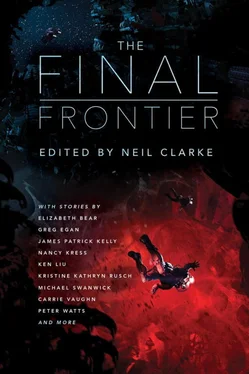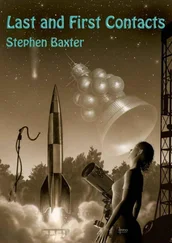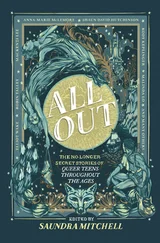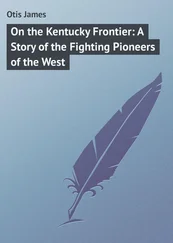I swallowed. Waited a moment, to push away my anger, before I met her gaze. “Yeah,” I said. “It hurt me too. We’re all hurt.”
A moment passed in silence. Anyahera stared down into her glass, turning it a little, so that her reflected face changed and bent.
“To new ideas,” she said, a little toast that said with great economy everything I had hoped for, especially the apologies.
“To new ideas.”
“Should we go and—?” She made a worried face and pointed to the ceiling, the sky, where Thienne would be racing the causality of her own hurt, exploring some distant angle of the microwave background, as far from home as she could make the simulation take her.
“Not just yet,” I said. “In a little while. Not just yet.”
THE DEEPS OF THE SKY
ELIZABETH BEAR
Elizabeth Bear was born on the same day as Frodo and Bilbo Baggins, but in a different year. She is the Hugo, Sturgeon, Locus, and Campbell Award winning author of thirty novels (The most recent is The Stone in the Skull , an epic fantasy from Tor) and over a hundred short stories. She lives in Massachusetts with her husband, writer Scott Lynch.
Stormchases’ little skiff skipped and glided across the tropopause, skimming the denser atmosphere of the warm cloud-sea beneath, running before a fierce wind. The skiff’s hull was broad and shallow, supported by buoyant pontoons, the whole designed to float atop the heavy, opaque atmosphere beneath. Stormchases had shot the sails high into the stratosphere and good winds blew the skiff onward, against the current of the dark belt beneath.
Ahead, the vast ruddy wall of a Deep Storm loomed, the base wreathed in shreds of tossing white mist: caustic water clouds churned up from deep in the deadly, layered troposphere. The Deep Storm stretched from horizon to horizon, disappearing at either end in a blur of perspective and atmospheric haze. Its breadth was so great as to make even its massive height seem insignificant, though the billowing ammonia cloud wall was smeared flat-topped by stratospheric winds where it broke the tropopause.
The storm glowed with the heat of the deep atmosphere, other skiffs silhouetted cool against it. Their chatter rang over Stormchases’ talker. Briefly, he leaned down to the pickup and greeted his colleagues. His competition. Many of them came from the same long lines of miners that he did; many carried the same long-hoarded knowledge.
But Stormchases was determined that, with the addition of his own skill and practice, he would be among the best sky-miners of them all.
Behind and above, clear skies showed a swallowing indigo, speckled with bright stars. The hurtling crescents of a dozen or so of the moons were currently visible, as was the searing pinpoint of the world’s primary—so bright it washed out nearby stars. Warmth made the sky glow too, the variegated brightness of the thermosphere far above. Stormchases’ thorax squeezed with emotion as he gazed upon the elegant canopies of a group of Drift-Worlds rising in slow sunlit coils along the warm vanguard of the Deep Storm, their colours bright by sunlight, their silhouettes dark by thermal sense.
He should not look; he should not hope. But there—a distance-hazed shape behind her lesser daughters and sisters, her great canopy dappled in sheeny gold and violet—soared the Mothergraves. Stormchases was too far and too low to see the teeming ecosystem she bore on her vast back, up high above the colourful clouds where the sunlight could reach and nurture them. He could just make out the colour variations caused by the dripping net-roots of veil trees that draped the Mothergraves’ sides, capturing life-giving ammonia from the atmosphere and drawing it in to plump leaves and firm nutritious fruit.
Stormchases arched his face up to her, eyes shivering with longing. His wings hummed against his back. There was no desire like the pain of being separate from the Mothergraves, no need like the need to go to her. But he must resist it. He must brave the Deep Storm and harvest it, and perhaps then she would deem him worthy to be one of hers. He had the provider-status to pay court to one of the younger Drift-Worlds… but they could not give his young the safety and stability that a berth on the greatest and oldest of the Mothers would.
In the hot deeps of the sky, too high even for the Mothers and their symbiotic colony-flyers or too low even for the boldest and most intrepid of Stormchases’ brethren, other things lived.
Above were other kinds of flyers and the drifters, winged or buoyant or merely infinitesimal things that could not survive even the moderate pressure and chill of the tropopause. Below, swimmers dwelled in the ammoniated thicks of the mid-troposphere that never knew the light of stars or sun. They saw only thermally. They could endure massive pressures, searing temperatures, and the lashings of molten water and even oxygen, the gas so reactive that it could set an exhalation on fire . That environment would crush Stormchases to a pulp, dissolve his delicate wing membranes, burn him from the gills to the bone.
Stormchases’ folk were built for more moderate climes—the clear skies and thick, buoying atmosphere of the tropopause, where life flourished and the skies were full of food. But even here, in this temperate part of the sky, survival required a certain element of risk. And there were things that could only be mined where a Deep Storm pulled them up through the layers of atmosphere to an accessible height.
Which was why Stormchases sailed directly into the lowering wings of the Deep Storm, one manipulator on the skiff’s controls, the other watching the perspective-shrunken sail shimmering so high above. Flyers would avoid the cable, which was monofilament spun into an intentionally refractive, high-visibility lattice with good tensile properties. But the enormous, translucent-bodied Drift-Worlds were not nimble. Chances were good that the Mother would survive a sail-impact, albeit with some scars—and some damage to the sky-island ecosystems she carried on her backs—and the skiff would likely hold together through such an incident. If he tangled a Mother in the monofilament shroud-lines spun from the same material that reinforced the Drift-World’s great canopies… it didn’t bear thinking of. That was why the lines were so gaily streamered: so anyone could see them from afar.
If Stormchases lost the skiff, it would just be a long flight home and probably a period of indenture to another miner until he could earn another, and begin proving himself again. But injuring a Mother, even a minor one who floated low, would be the end of his hopes to serve the Mothergraves.
So he watched the cable, and the overhead skies. And—of course—the storm.
Stormchases could smell the Deep Storm now, the dank corrosive tang of water vapour stinging his gills. The richly coloured billows of the Deep Storm proved it had something to give. The storm’s dark-red wall churned, marking the boundary of a nearly-closed atmospheric cell rich with rare elements and compounds pumped up from the deeps. Soon, Stormchases would don his protective suit, seal the skiff, and begin the touchy business—so close to the storm—of hauling in the sail. The prevailing wind broke around the Deep Storm, eddying and compacting as it sped past those towering clouds. The air currents there were even more dangerous and unnavigable than those at the boundary between the world’s temperate and subtropical zones, where two counter-rotating bands of wind met and sheared against each other.
And Stormchases was going to pass through it.
Once the sail was stowed, Stormchases would manoeuvre the skiff closer under engine power—as close as those cool silhouettes ahead—and begin harvesting. But he would not be cowed by the storm wall. Could not be, if he hoped to win a berth on the Mothergraves.
Читать дальше












